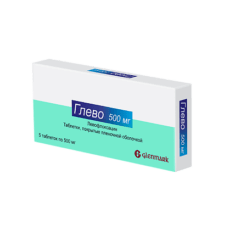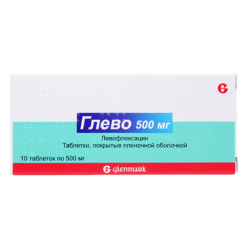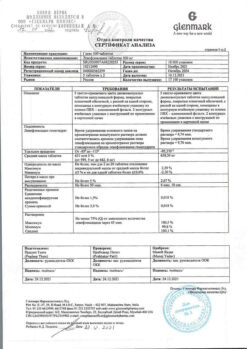No products in the cart.
Glevo, 500 mg 25 pcs.
€5.89 €5.24
Out of stock
(E-mail when Stock is available)
Description
Pharmacological action – broad spectrum antimicrobial, bactericidal.
Pharmacodynamics
Glevo (levofloxacin) is a broad spectrum antimicrobial bactericidal agent of fluoroquinolones group. It blocks DNA-enzyme (topoisomerase II) and topoisomerase IV, breaks superspiralization and cross-linking of DNA breaks, inhibits DNA synthesis, causes deep morphological changes in cytoplasm, cell wall and membranes.
The following aerobic gram-positive organisms are sensitive to the drug: Corynebacterium diphtheriae, Enterococcus faecalis, Enterococcus spp, Listeria monocytogenes, Staphylococcus coagulase-negative methicillin-sensitive and methicillin-moderately sensitive, Staphylococcus aureus methicillin-sensitive, Staphylococcus epidermidis methicillin-sensitive, Staphylococcus spp, Streptococci group C and G, Streptococcus agalactiae, Streptococcus pneumoniae penicillin-sensitive/moderately sensitive/resistant, Streptococcus pyogenes and Viridans penicillin-moderately sensitive/resistant; aerobic gram-negative microorganisms: Acinetobacter baumannii, Acinetobacter spp, Actinobacillus actinomycetemcomitans, Citrobacter freundii, Eikenella corrodens, Enterobacter aerogenes, Enterobacter agglomerans, Enterobacter cloacae, Enterobacter spp, Escherichia coli, Gardnerella vaginalis, Haemophilus ducreyi, Haemophilus influenzae ampicillin-sensitive/resistant, Haemophilus parainfluenzae, Helicobacter pylori, Klebsiella oxytoca, Klebsiella pneumoniae, Klebsiella spp, Moraxella catarrhalis β+/β-, Morganella morganii, Neisseria gonorrhoeae (non-penicillinase producing/penicillinase producing), Neisseria meningitidis, Pasteurella canis, Pasteurella dagmatis, Pasteurella multocida, Pasteurella spp, Proteus mirabilis, Proteus vulgaris, Providencia rettgeri, Providencia stuartii, Providencia spp, Pseudomonas aeruginosa, Pseudomonas spp., Salmonella spp., Serratia marcescens, Serratia spp.; anaerobic microorganisms: Bacteroides fragilis, Bifidobacterium spp., Clostridium perfringens, Fusobacterium spp., Peptostreptococcus spp., Propionibacterium spp, Veillonella spp.; other microorganisms: Bartonella spp., Chlamydia pneumoniae, Chlamydia psittaci, Chlamydia trachomatis, Legionella pneumophila, Legionella spp., Mycobacterium leprae, Mycobacterium tuberculosis, Mycobacterium spp., Mycoplasma hominis, Mycoplasma pneumoniae, Rickettsia spp., Ureaplasma urealyticum.
Pharmacokinetics
In oral administration it is quickly and almost completely absorbed (eating has little effect on the speed and completeness of absorption). Bioavailability is 99%. Tmax is 1-2 h; when administered in 250 and 500 mg, Cmax in blood is 2.8 and 5.2 mcg/ml, respectively. The binding to plasma proteins is 30-40%.
It penetrates well into organs and tissues – lungs, bronchial mucosa, sputum, urogenital organs, polymorphonuclear leukocytes, alveolar macrophages.
In the liver, a small portion is oxidized and/or deacetylated. Renal clearance is 70% of total clearance. T1/2 is 6-8 hours. It is eliminated mainly by the kidneys through glomerular filtration and tubular secretion. Less than 5% of levofloxacin is excreted as metabolites. During 24 hours 70% is eliminated unchanged by the kidneys and during 48 hours – 87%; during 72 hours in the intestine it is eliminated 4% of the dose taken orally.
Indications
Indications
Bacterial infections sensitive to levofloxacin in adults:
– acute sinusitis;
– exacerbation of chronic bronchitis;
– community-acquired pneumonia;
– uncomplicated urinary tract infections;
– complicated urinary tract infections (including acute pyelonephritis);
– chronic bacterial prostatitis;
– infections of the skin and soft tissues;
– septicemia/bacteremia associated with the above indications;
– abdominal infections;
– comprehensive treatment of drug-resistant forms of tuberculosis.
Pharmacological effect
Pharmacological effect
Pharmacological action – antimicrobial, broad-spectrum bactericidal.
Pharmacodynamics
Glevo (levofloxacin) is a broad-spectrum antimicrobial bactericidal agent from the group of fluoroquinolones. Blocks DNA gyrase (topoisomerase II) and topoisomerase IV, disrupts supercoiling and cross-linking of DNA breaks, suppresses DNA synthesis, causes profound morphological changes in the cytoplasm, cell wall and membranes.
Aerobic gram-positive organisms are sensitive to the drug: Corynebacterium diphtheriae, Enterococcus faecalis, Enterococcus spp., Listeria monocytogenes, Staphylococcus coagulase-negative methicillin-sensitive and methicillin-moderately sensitive, Staphylococcus aureus methicillin-sensitive, Staphylococcus epidermidis methicillin-sensitive, Staphylococcus spp., Streptococci groups C and G, Streptococcus agalactiae, Streptococcus pneumoniae penicillin-sensitive/moderately sensitive/resistant, Streptococcus pyogenes and Viridans penicillin-moderately sensitive/resistant; aerobic gram-negative microorganisms: Acinetobacter baumannii, Acinetobacter spp., Actinobacillus actinomycetemcomitans, Citrobacter freundii, Eikenella corrodens, Enterobacter aerogenes, Enterobacter agglomerans, Enterobacter cloacae, Enterobacter spp., Escherichia coli, Gardnerella vaginalis, Haemophilus ducreyi, Haemophilus influenzae ampicillin-sensitive/resistant, Haemophilus parainfluenzae, Helicobacter pylori, Klebsiella oxytoca, Klebsiella pneumoniae, Klebsiella spp., Moraxella catarrhalis β+/β−, Morganella morganii, Neisseria gonorrhoeae (non-penicillinase-producing/penicillinase-producing), Neisseria meningitidis, Pasteurella canis, Pasteurella dagmatis, Pasteurella multocida, Pasteurella spp., Proteus mirabilis, Proteus vulgaris, Providencia rettgeri, Providencia stuartii, Providencia spp., Pseudomonas aeruginosa, Pseudomonas spp., Salmonella spp., Serratia marcescens, Serratia spp.; anaerobic microorganisms: Bacteroides fragilis, Bifidobacterium spp., Clostridium perfringens, Fusobacterium spp., Peptostreptococcus spp., Propionibacterium spp., Veillonella spp.; other microorganisms: Bartonella spp., Chlamydia pneumoniae, Chlamydia psittaci, Chlamydia trachomatis, Legionella pneumophila, Legionella spp., Mycobacterium leprae, Mycobacterium tuberculosis, Mycobacterium spp., Mycoplasma hominis, Mycoplasma pneumoniae, Rickettsia spp., Ureaplasma urealyticum.
Pharmacokinetics
When taken orally, it is quickly and almost completely absorbed (food intake has little effect on the speed and completeness of absorption). Bioavailability – 99%. Tmax – 1–2 hours; when taking 250 and 500 mg, Cmax in the blood is 2.8 and 5.2 mcg/ml, respectively. Bonding with plasma proteins is 30–40%.
Penetrates well into organs and tissues – lungs, bronchial mucosa, sputum, organs of the genitourinary system, polymorphonuclear leukocytes, alveolar macrophages.
In the liver, a small portion is oxidized and/or deacetylated. Renal clearance accounts for 70% of the total clearance. T1/2 – 6–8 hours. Excreted from the body mainly by the kidneys through glomerular filtration and tubular secretion. Less than 5% of levofloxacin is excreted as metabolites. In unchanged form, 70% is excreted by the kidneys within 24 hours and 87% within 48 hours; 4% of the dose taken orally is found in the intestines within 72 hours.
Special instructions
Special instructions
Although levofloxacin is more soluble than other quinolones, patients should be kept adequately hydrated.
During treatment, it is necessary to avoid solar and artificial UV irradiation to avoid damage to the skin (photosensitization).
If signs of tendonitis or pseudomembranous colitis appear, levofloxacin is immediately discontinued and appropriate therapy is prescribed.
It should be borne in mind that in patients with a history of brain damage (stroke, severe trauma), seizures may develop; with glucose-6-phosphate dehydrogenase deficiency, the risk of hemolysis increases.
Impact on the ability to drive vehicles and operate machinery. During the treatment period, care must be taken when driving vehicles and engaging in other potentially hazardous activities that require increased concentration and speed of psychomotor reactions.
Active ingredient
Active ingredient
Levofloxacin
Composition
Composition
1 film-coated tablet contains:
active substance:
levofloxacin (as hemihydrate) – 500.00 mg,
excipients: MCC; starch; povidone (K30); crospovidone; magnesium stearate; Avicel pH 101 (MCC),
film shell: hypromellose; macrogol (polyethylene glycol 6000); dibutyl phthalate; talc; titanium dioxide; iron oxide red dye; iron oxide yellow dye (tablets, 500 mg).
Contraindications
Contraindications
– hypersensitivity to levofloxacin and other fluoroquinolones;
– epilepsy;
– tendon damage due to previous treatment with quinolones;
– pregnancy;
– lactation period;
– children and adolescents up to 18 years of age.
With caution: older age (high likelihood of concomitant decline in renal function); deficiency of glucose-6-phosphate dehydrogenase.
Side Effects
Side Effects
The side effects listed below are presented in accordance with the following gradations of frequency of their occurrence: very often (≥1/10); often (≥1/100, <1/10); uncommon (≥1/1000, <1/100); rare (≥1/10000, <1/1000); very rare (<1/10000), including isolated reports; unknown frequency (it is not possible to determine the frequency of occurrence based on available data).
Data from clinical studies of levofloxacin
From the heart: rarely – sinus tachycardia; unknown frequency – prolongation of the QT interval.
From the blood and lymphatic system: uncommon – leukopenia (decreased number of leukocytes in peripheral blood), eosinophilia (increased number of eosinophils in peripheral blood); rarely – neutropenia (decreased number of neutrophils in peripheral blood), thrombocytopenia (decreased number of platelets in peripheral blood); unknown frequency – pancytopenia (decrease in the number of all formed elements in the peripheral blood), agranulocytosis (absence or sharp decrease in the number of granulocytes in the peripheral blood), hemolytic anemia.
From the nervous system: often – headache, dizziness; infrequently – drowsiness, tremor, dysgeusia (taste perversion); rarely – paresthesia, convulsions; unknown frequency – peripheral sensory neuropathy, peripheral sensorimotor neuropathy, dyskinesia, extrapyramidal disorders, loss of taste, parosmia (disorder of the sense of smell, especially the subjective sensation of an objectively absent smell), including loss of smell.
From the side of the organ of vision: very rarely – visual disturbances, such as blurriness of the visible image.
From the organ of hearing and labyrinthine disorders: infrequently – vertigo (a feeling of deviation or spinning – either of one’s own body or of surrounding objects); rarely – ringing in the ears; unknown frequency – hearing loss.
From the respiratory system, chest and mediastinal organs: infrequently – shortness of breath; unknown frequency – bronchospasm, allergic pneumonitis.
From the gastrointestinal tract: often – diarrhea, vomiting, nausea; infrequently – abdominal pain, dyspepsia; unknown frequency – hemorrhagic diarrhea, which in very rare cases may be a sign of enterocolitis, including pseudomembranous colitis.
From the kidneys and urinary tract: infrequently – increased concentration of creatinine in the blood serum; rarely – acute renal failure (for example, due to the development of interstitial nephritis).
From the skin and subcutaneous tissues: infrequently – rash, itching, urticaria; unknown frequency – toxic epidermal necrolysis, Stevens-Johnson syndrome, exudative erythema multiforme, photosensitivity reactions (increased sensitivity to solar and UV radiation), leukocytoclastic vasculitis. Reactions from the skin and mucous membranes can sometimes develop even after taking the first dose of the drug.
From the musculoskeletal system and connective tissue: infrequently – arthralgia, myalgia; rarely – tendon damage, including tendonitis (for example, Achilles tendon), muscle weakness, which can be especially dangerous in patients with pseudoparalytic myasthenia gravis; unknown frequency – rhabdomyolysis, tendon rupture (for example, Achilles tendon). This side effect can be observed within 48 hours after the start of treatment and is bilateral.
From the side of metabolism and nutrition: infrequently – anorexia; rarely – hypoglycemia, especially in patients with diabetes mellitus (possible signs of hypoglycemia: voracious appetite, nervousness, perspiration, trembling).
Infectious and parasitic diseases: infrequently – fungal infections, development of resistance of pathogenic microorganisms.
From the side of blood vessels: rarely – decreased blood pressure.
General disorders: infrequently – asthenia; rarely – pyrexia (fever).
From the immune system: rarely – angioedema; unknown frequency – anaphylactic shock, anaphylactoid shock. Anaphylactic and anaphylactoid reactions can sometimes develop even after taking the first dose of the drug.
From the liver and biliary tract: often – increased activity of liver enzymes in the blood (for example ALT, AST); infrequently – increased concentration of bilirubin in the blood; unknown frequency – severe liver failure, including cases of acute liver failure, especially in patients with a severe underlying disease (for example, sepsis), hepatitis.
Mental disorders: often – insomnia; infrequently – feeling of anxiety, confusion; rarely – mental disorders (for example, with hallucinations), depression, agitation (excitement), sleep disturbances, nightmares; unknown frequency – mental disorders with behavioral disorders with self-harm, including suicidal thoughts and suicide attempts.
Other possible adverse effects that apply to all fluoroquinolones
Very rare – attacks of porphyria (a very rare metabolic disease) in patients already suffering from this disease.
Interaction
Interaction
Increases T1/2 of cyclosporine.
The effect of the drug is reduced by drugs that inhibit intestinal motility: sucralfate, aluminum-/magnesium-containing antacid drugs and iron salts (a break of at least 2 hours is required between doses).
NSAIDs and theophylline increase convulsive readiness.
GCS increases the risk of tendon rupture.
Cimetidine and drugs that block tubular secretion slow down excretion.
Hypoglycemic drugs: Strict control of blood glucose levels is necessary because there is a possibility of hyper- and hypoglycemia when used simultaneously with levofloxacin.
Overdose
Overdose
Symptoms: nausea, erosive lesions of the mucous membranes of the gastrointestinal tract, prolongation of the QT interval, confusion, dizziness, convulsions.
Treatment: symptomatic, dialysis is ineffective.
Storage conditions
Storage conditions
In a dry place, protected from light, at a temperature not exceeding 25 °C
Shelf life
Shelf life
2 years
Manufacturer
Manufacturer
Glenmark Pharmaceuticals Ltd, India
Additional information
| Shelf life | 2 years |
|---|---|
| Conditions of storage | In a dry, light-protected place at a temperature not exceeding 25 °C |
| Manufacturer | Glenmark Pharmaceuticals Ltd, India |
| Medication form | pills |
| Brand | Glenmark Pharmaceuticals Ltd |
Other forms…
Related products
Buy Glevo, 500 mg 25 pcs. with delivery to USA, UK, Europe and over 120 other countries.


















